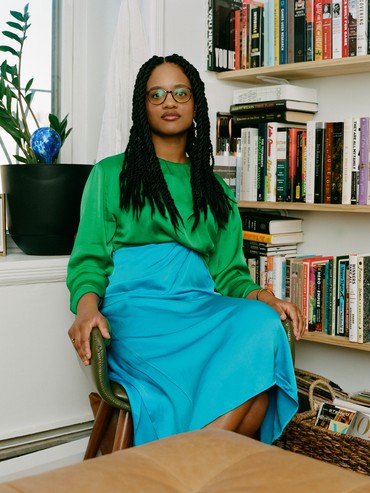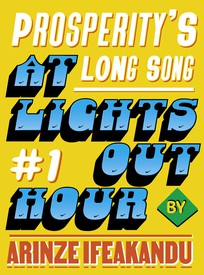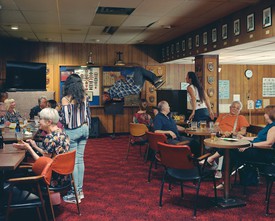
Fiona Duncan is a Canadian-American author and organizer and the founder of the social literary practice Hard to Read. Duncan’s debut novel, Exquisite Mariposa (Soft Skull Press), won a 2020 Lambda Award. She is currently developing a narrative biography and critical study of the transdisciplinary American artist Pippa Garner.

Jeff Henrikson is a New York City–based photographer whose work focuses on portraiture and revolves around the eclectic worlds of art, fashion, and music. He has contributed to many publications, including W, Vogue, L’Uomo Vogue, and A Magazine Curated By. Photo: Daniel Arnold
Between the lines and behind the scenes of the books you love, there are editors. Talent scouts and mentors, culture shapers and gatekeepers, they decide which manuscripts make it to print, and how. And yet, unlike the producers of films, magazines, and newspapers, book editors aren’t credited on the products they put out. Their hand is traditionally invisible, their moves covert.
A new generation of editors is coming into power and changing the standards of publishing—including how transparent they are about their methods. Still modest as a group, book editors are more than ever assuming a public role, advocating for their books and authors and developing reputations of their own. The book editor’s new media-presence functions to demystify the publishing process, welcoming a new cast of talent into its traditional ivory tower. A democratization of books.
From long-standing houses to new specialty imprints, from mainstream to experimental, across literary genres and formats, the six editors profiled here are taking risks, bringing exciting, necessary voices to the fore. Likening their labor to parenting, midwifery, public health, and caretaking, they take their responsibilities—to their authors, their readers, and to culture at large—very seriously. None deny that they are tastemakers, and that following their taste is their charge.
The editor’s vocation is to facilitate storytelling. Their own stories are rarely told.
Callie and Jean Garnett
Identical twins with the same job at different companies, editors Callie (at Bloomsbury) and Jean (at Little, Brown) Garnett often find themselves going after the same projects. “I tried to convince my team that we should buy Post-traumatic,” says Callie of one of Jean’s forthcoming titles. “And I tried to convince my team that we should buy Little Rabbit,” Jean rejoins.
When Chantal V. Johnson’s Post-traumatic and Alyssa Songsiridej’s Little Rabbit—two debut novels, “both quite sexy,” according to Jean—were released this spring, the Garnett twins promoted them equally on their shared Instagram account, as they do with all of the titles they edit. “We had to work out a situation where if one of us won the book that both of us wanted, that was a win for both,” Jean explains of their social media presence. “We wanted a place where we could celebrate each other,” Callie continues. “So that was the idea behind it,” Jean concludes. “Let’s find a way to talk about our competition that’s empowering for both of us.”
Jean was the first of the twins to enter publishing: she was assisting Reagan Arthur, now the publisher of Knopf, in 2014 while Callie was an unhappy PhD candidate. Both had previously attended Bard College in the Hudson Valley, studying literature as undergraduates. (Callie was there first; Jean had started at Oberlin College before swiftly transferring to Bard to be with her twin.) Drawn to the work Jean was doing—“It seemed to me that her stress was more exciting than mine”—Callie was set up by her sister for an informational interview with George Gibson, then the publisher at Bloomsbury. When an internship opened up at that company, “I was there and I worked up from there.”
Longing and mutual support between twins—ping-ponging with competition and envy—are the subject of a personal essay, “There I Almost Am,” that Jean recently published in the Yale Review. It was Jean’s first time being edited and “such a transformative process. . . . [It] gave me a lot more empathy for the authors that I work with.” Jean had only started writing “in a serious and regular way since becoming a mother,” in 2018. Callie, meanwhile, has published several chapbooks and one full-length book of poetry, Wings in Time (Song Cave, 2021). Each sister’s writing practice links back to the first authors and books that marked them. For psychological-intimacy-mining Jean, that was George Eliot, Toni Morrison’s Sula (1973), and Dostoevsky’s Notes from Underground (1864). And for expansive poet Callie: Arthur Rimbaud, Amiri Baraka, and George Oppen’s Of Being Numerous (1965). If her poetry practice connects with her job as an editor, it’s maybe, Callie suggests, about being “an arranger of materials as much as a generator of them.”
The books Callie has worked on at Bloomsbury range from Anna North’s bestselling “speculative Western” Outlawed (2021) to American cultural histories such as Rachel Louise Snyder’s No Visible Bruises (2019), on domestic violence. Chasing Me to My Grave: An Artist’s Memoir of the Jim Crow South collects paintings and prose by Winfred Rembert, while Long Live the Tribe of Fatherless Girls is a coming-of-age from T Kira Madden, the niece of the footwear designer Steve Madden. Jean agrees with Callie in having no specific directive other than to “follow our taste,” and her list at Little, Brown is also a mix. Millennial literature is a current, though, with young authors Megan Nolan, Cyrus Simonoff (published as Cyrus Dunham), Jeremy Atherton Lin, and comedian Jenny Slate. There’s also Malcolm Harris, whose Kids These Days: Human Capital and the Making of Millennials (2017) analyzed the economics behind their generation’s stereotypes, and Sean Thor Conroe, of Fuccboi (2022), a book that’s being lauded and disparaged (either way, read) as emblematic millennial-male lit.
“More twin content,” Callie affirms Jean during their joint interview. “We really need to get on it.” (They agree to post more pictures of themselves on their Instagram @publishingtwins. In one, they say, from when they are very young, not even they can tell who is who.) “People are fascinated by twins,” Callie continues. Both she and Jean are happy to give the public what it wants, as they too are amazed by their doubling. “We literally spoke in our own language to each other,” they share, “before we spoke to anyone else.”
Nicole Counts
“I think books are public health,” says Nicole Counts, a senior editor at One World. “Books are necessary. There needs to be a democratization of books.”
Reinstituted under the leadership of Chris Jackson, One World is a division of Penguin Random House devoted to, as Counts describes it, “books about and for liberation. Through fiction, nonfiction, humor, and poetry, it’s all about getting closer to this idea of freedom: individual freedom, collective freedom, bodily freedom.”
Among One World’s award-winning authors is Ta-Nehisi Coates, whose 2017 essay collection We Were Eight Years In Power served to relaunch the imprint, “originally founded in 1991 by a few Black women” including Cheryl Woodruff, Counts explains. “Their intention, apparent in the name, was to publish books from all over the world with grace, care, and emphasis.” Counts recalls One World’s relaunch celebration with Coates, a panel event followed by an after-party with lots of champagne that she assumed would make the editorial team slow into work the next day. “All of us,” she says of Jackson, herself, and their fellow founding colleague Victory Matsui, “arrived by 8:00 am the next morning. We were just so excited. It was like living off this high.”
At One World, Counts gets to edit across formats and finds toggling between them—“poetry to short stories to [long-form] fiction to nonfiction”—instructive “because each helps me understand how to build stories in different ways.” Nonetheless, she can’t edit more than one book at a time. A self-described “binge editor” who works intensely and sequentially, immersing herself in one world after the next, Counts recently shifted from editing a nonfiction history of the crack-cocaine epidemic in the United States to something “completely different, a novel about a Black ballerina who becomes the first principal at the New York City Ballet.”
Whatever the book’s format, Counts feels her role as an editor is to be a good reader and to remember that “publishing books has to also be an action,” in the tradition of bell hooks’s description of love as action. Counts also wonders if “editors are selfish to some extent. . . . Maybe we’re picking authors and we’re picking books that we want to heal us. I can’t express enough how much I’ve healed and been awakened by the process.”
One of Counts’s awakenings as an editor involved Coates. When she was thirteen years old, she read Jackie Woodson’s If You Come Softly (1998), “a novel about finding your people” that inspired her career. “How do I do what she did?” Counts asked her seventh-grade teacher in New Jersey about Woodson. She was confident: “This is what I want to do.” After getting practical counsel from her teacher on how to become a writer or editor, “fast forward literally a decade later” and Counts was assisting Jackson as he was publishing Coates, who had been given an advance copy of Woodson’s latest book. Through this connection Counts was able to interview the author who changed her life.
“The day I met Jackie Woodson,” Counts shares, “was also the day that I met Trayvon Martin’s parents, because Chris had published their book.” When Martin was shot and killed by a stranger in an act of racist violence, he was seventeen—two years older than the lovers in If You Come Softly, one of whom, a young Black boy, is (without ruining the ending completely) struck by a similar tragedy. Back in middle school, Counts had been moved by “the beautiful blossom of friendship and the truest kind of love” in Woodson’s book. Now its political reality was resounding, reminding her of the importance of the work that she does—publishing literature as an action—and what she loves about great books. “There’s all these truths of books,” Counts reflects. “You read it once and you feel whatever truth is associated with what you’re going through and then you can read it again years later and see a whole different story.”
Jackson Howard
When Jackson Howard started work as an intern at Farrar, Straus and Giroux (FSG) in 2016, he had a moment of doubt. Was he meant to be there? “It wasn’t impostor syndrome,” he explains, though that would have been understandable for a twenty-two-year-old graduate in English who found himself working in an office decorated with National Book Awards and Nobel and Pulitzer prizes. FSG had published many of Howard’s favorite books and authors, including Jeffrey Eugenides, Joan Didion, and Pablo Neruda. He’d been awed by the legacy imprint (founded in 1946) for as long as he’d understood that books have publishers. His interest wasn’t up for review, nor was his aptitude—only his extracurriculars. Moonlighting as a music critic, “I would stay out late,” he remembers, “going to concerts and warehouse parties.” He had a life outside literature. He was enmeshed in queer community. The diversity of his passions was reflected in how he read—not just FSG titles or the books on the New York Times bestseller list but also the output of small, experimental, and indie presses, as well as writing online. These tastes, though, proved to be well within the traditions of his workplace. Look at Susan Sontag, a prolific FSG author: she famously spent more time in theaters, cinemas, nightclubs, traveling, and in bed with incredible women than she did at her desk. Literature is about life, after all; anything and everything can belong. Once Howard realized this, his career took off.
Now in his sixth year at FSG, Howard is a full-time editor there and at its imprint MCD. He has developed a reputation for publishing successful books—reader and reviewer favorites, many of them going up for awards—that subvert mainstream literary standards. Since “doubling down on who I am as a music writer, as a queer man, and as somebody from California” (Howard grew up in Los Angeles), his list has flourished. He’s publishing Susan Straight, “who to me is the great living California writer”; he’s publishing Ryan Schreiber, founder of the music site Pitchfork; and this summer he’ll release an insider’s look at the girl fans of boy bands, Kaitlyn Tiffany’s Everything I Need I Get from You.
The most culturally transformative books on Howard’s roster are—by far and so far—his queer acquisitions. Seeking a broader audience, both Sarah Schulman and Judith Butler, internationally regarded authors of paradigm-shifting academic and political literature, have trusted their most recent nonfiction works to Howard, who is four decades their junior. Meanwhile last year’s 100 Boyfriends—“an unapologetically queer and Black book,” as Howard describes it, by Brontez Purnell, a punk for life who was previously published by the Feminist Press—won the hearts both of fun boys who don’t usually read and of devoted readers with minimal access to the fun-boy lifestyle. (The book is sex and romance from beginning to end, and funny.)
One of Howard’s most hotly anticipated titles is a reissue of Imogen Binnie’s out-of-print 2013 novel Nevada, which, he observes, “amongst trans people is something of a holy grail, a Bible.” The project came to him through his friend Torrey Peters, author of the best-selling book and soon-to-be television series Detransition, Baby (2021). That book was published not by FSG but by Penguin Random House, but Howard had helped Peters get an agent, something he has done with many of his own authors as well. “Unsurprisingly,” he explains, “a lot of queer writers are not represented by agents. They’ve been marginalized and don’t trust the classic systems that publishing works within.” Sensitive to this, Howard serves as more than just an editor on the page—from contract negotiations through publicity tours and reviews, he is an advocate, a guide, and a confidant for exceptional talent entering an industry that is finally wising up and privileging voices like theirs. And his authors love him for it—so much that one of them even got their editor’s full name tattooed on their forearm.
Angeline Rodriguez
“To entertain a sort of bioessentialist metaphor,” Angeline Rodriguez laughs, “I see being an agent and an editor as being a kind of midwife. We’re not creating the art, but we are bringing it into the world and making it a reality in a way that hopefully enables it to have a long life beyond our influence.” The boundaries between fantasy and reality—the not yet created and the soon to come—have been pushed and questioned in the books Rodriguez has published at Orbit, the genre and speculative-fiction imprint of Hachette Book Group, where she worked as an editor from 2019 until this spring, when the esteemed William Morris Endeavor (WME) agency courted her to join it.
“The perennial challenge of futuristic speculative fiction,” Rodriguez says, “is to stay ahead of what’s actually happening.” This can be challenging, she allows, when our world reads more like science fiction every day. Audiences love it when a book proves prophetic, as did Octavia Butler’s 1993 novel Parable of the Sower, “predicting this demagogue who’s going to rise to power with literally the slogan ‘Make America Great Again.’” But Rodriguez, a Venezuelan American who grew up in Houston, Texas, is fast to insist that “the idea of there being a firm boundary between our world and the speculative is an illusion.” There has always been “a robust politics to imagining alternate worlds,” be they dystopian or utopian. “Someone’s utopia is always somebody else’s dystopia,” Rodriguez explains, so what seems like a futuristic prediction may simply be the documentation of a present reality that others can’t yet see.
These very ideas play out in two of the books Rodriguez recently published, both of which graced best-of and bestseller lists: Lincoln Michel’s The Body Scout and Marissa Levien’s The World Gives Way (both 2021). “Set in a near-future New York overcome by income inequality, health-care debt, and failing bodies that need to be modified,” in Rodriguez’s words, The Body Scout sounds like many Americans’ lives today. The World Gives Way “takes the traditional sci-fi concept of ‘generation ship’”: with Earth suddenly uninhabitable, “all of humanity will get on this great ship and go to a new planet as if our future is boundless, the final frontier,” but the book asks, “At what cost would that come?” Unlike most “generation ship” stories, of which there are many, Levien’s is written from the perspective of a servant whose grandmother signed a contract indenturing herself and the lives of her kin in order to board the ship. Easy to read as an analogy for serfdom and the cycles of poverty associated with colonialism, The World Gives Way also mirrors a futuristic plan announced by Tesla and SpaceX CEO Elon Musk the very year the book came out: to get to Mars, humans could buy or work their way there.
There are whispers in the entertainment industry that Rodriguez’s first solo acquisition, Micaiah Johnson’s The Space between Worlds (2020), might soon be adapted for the screen. The story is cinematic. “A multiverse story”—many of the latest Marvel movies take place in a multiverse, a hypothetical group of multiple, parallel, or alternative universes—“about a queer woman of color who lives on the margins of a supposedly utopian society,” The Space between Worlds explores the “what if?” and “sliding door” moments of life, especially as they relate to trauma. “The dramatic action of the book,” Rodriguez details, “is very much tied to all the different versions of herself that the protagonist could have been if her traumas had been worse or better or avoided.” Rodriguez says the book’s premise of being on the margins within a seeming utopia was especially relatable to her “as someone from a traditionally underrepresented background who found herself in this ivory tower setting of publishing.” A bestseller and award-winner, Rodriguez’s first project clearly resonated with many people and set her on a course to continue to publish outstanding and diverse works in genres she has relied upon since she was a child.
Now twenty-eight years old, Rodriguez describes her child self as “the archetype” of a speculative and genre-fiction reader. “I recall spending a lot of time in the Barnes & Noble sci-fi aisles,” she says, “reading books off the shelves until somebody would tell me to leave.” Her parents didn’t have “a lot of resources for splashy extracurriculars, but books were always cheap, plentiful, and accessible.” A career as a literary editor or agent hadn’t occurred to Rodriguez—“in retrospect,” she reflects, “because generally such things are not marketed to someone of my demographics”—until a college advisor suggested she look into it. Rodriguez immediately “took to the idea of being able to shape what stories were ending up on those shelves that were an emotional support system as a kid.”
Kazim Ali
Nightboat Books cofounder Kazim Ali feels that “every writer should do work on behalf of a writer who is underread. If every person had one other person who they looked after, the whole of literature would be so much richer.”
A poet and cross-genre author himself, with nineteen books under his own name, Ali is setting the example he’s calling for—and then some. As if picking up the slack from the majority who don’t caretake, Ali has helped hundreds of books into the world, translating many from Farsi, Spanish, and French (including two novels by Marguerite Duras) as well as editing and publishing works by lesser-known, new, and young poets and writers with the same integrity he gives to established greats who he believes haven’t yet connected with their fullest possible readership.
Much of this effort is carried out through Nightboat, the imprint he cofounded in 2004. “I founded the press for Fanny,” Ali avows, speaking of Fanny Howe, the first author Nightboat published. Howe is an award-winning American poet and writer whose books of poetry were “very lauded and in-print,” Ali explains, “while her fiction, her prose, was not.” In 2004, Nightboat published, first, Howe’s experimental lyric essay The Lives of the Spirits/Glasstown: Where Something Got Broken, followed in 2006 by Radical Love, her five novels collected in one volume. For Ali, Howe represents “the kind of writing I like and want to do: powerful, emotionally intense lyrical writing informed by the strategies of innovation and experimentation,” writing that did not have a dedicated home until Nightboat came along.
Since its founding, Nightboat, a nonprofit, has put out over two hundred books in various genres from an international and intergenerational array of authors. Through all its risk-taking—not relying on “a star roster,” “publishing a lot of people’s first books”—Nightboat has consistently cleaned up in nominations, prizes, and awards. It even launched its own coveted “Nightboat Poetry Prize,” with Ali for years serving as the judge. To list some of the names Ali has nurtured at Nightboat, there’s Etel Adnan, Bhanu Kapil, Myung Mi Kim, Michael Burkard, Brandon Som, Laura Moriarty, Gillian Conoley, Joyelle McSweeney, and Brynne Rebele-Henry, who was only sixteen when he published Fleshgraphs, her first “mature, powerful, strong book.”
“I’m very careful with the words of others,” says Ali of his editing style. “I do a lot of ‘shape of the book’ kind of editing,” arranging which sections should go where, but on a line-by-line level, Ali prefers to trust his writers. Citing a Bernadette Mayer sonnet—“the one where she talks about the cobra commander from GI Joe”—as an example, Ali insists that editors “have to allow for the fact that the most mysterious moves or the ones that are the weirdest could be the most brilliant. There’s a way in which an editor can become an evil figure if they are trying to normalize somebody’s work or take away the craziness, the quirkiness, the oddest parts of it. You think, why’s the cobra commander in this poem? Yet that’s what makes the poem.”
Ali doesn’t work alone at Nightboat. After his original cofounder departed a few years after the house started, poet Stephen Motika joined as publisher. Three more directors and editors have recently come in. Encouraging the imprint to “develop its own identity” beyond him, Ali says, “It should represent the pluralism of all the people who are working on it together.” This has kept Nightboat fresh and relevant and kept Ali from getting too busy.
In the spirit of poetry—roving, limitless—Ali also edits anthologies and book series with presses other than Nightboat, serves as a judge for multiple national writing prizes, writes and publishes himself, and is now the chair of the Department of Literature at the University of California, San Diego. Meeting his Nightboat and teaching duties, just last year Ali also managed to publish a young-adult “choose your own adventure” fantasy fiction, The Citadel of Whispers, as well as a mature almost-memoir about one of his childhood homelands in Canada, where a local Indigenous community is presently in conflict with the government over water access and health. He also edited two collections: New Moons, a volume of contemporary writing by North American Muslims, and a book in Pleiades Press’s “Unsung Masters” series by Indian-American poet Shreela Ray. “Do I regret the countless hours that I put into doing this stuff instead of my own writing?” Ali wonders about his tendency to edit, mentor, teach, publish, and promote others, often before making time for himself. “Yes,” he admits. “But these are important projects. And nobody else was going to do them. Shreela Ray’s work was out of print for twenty-five years. How much longer were we going to wait?”
Photos: Jeff Henrikson
















